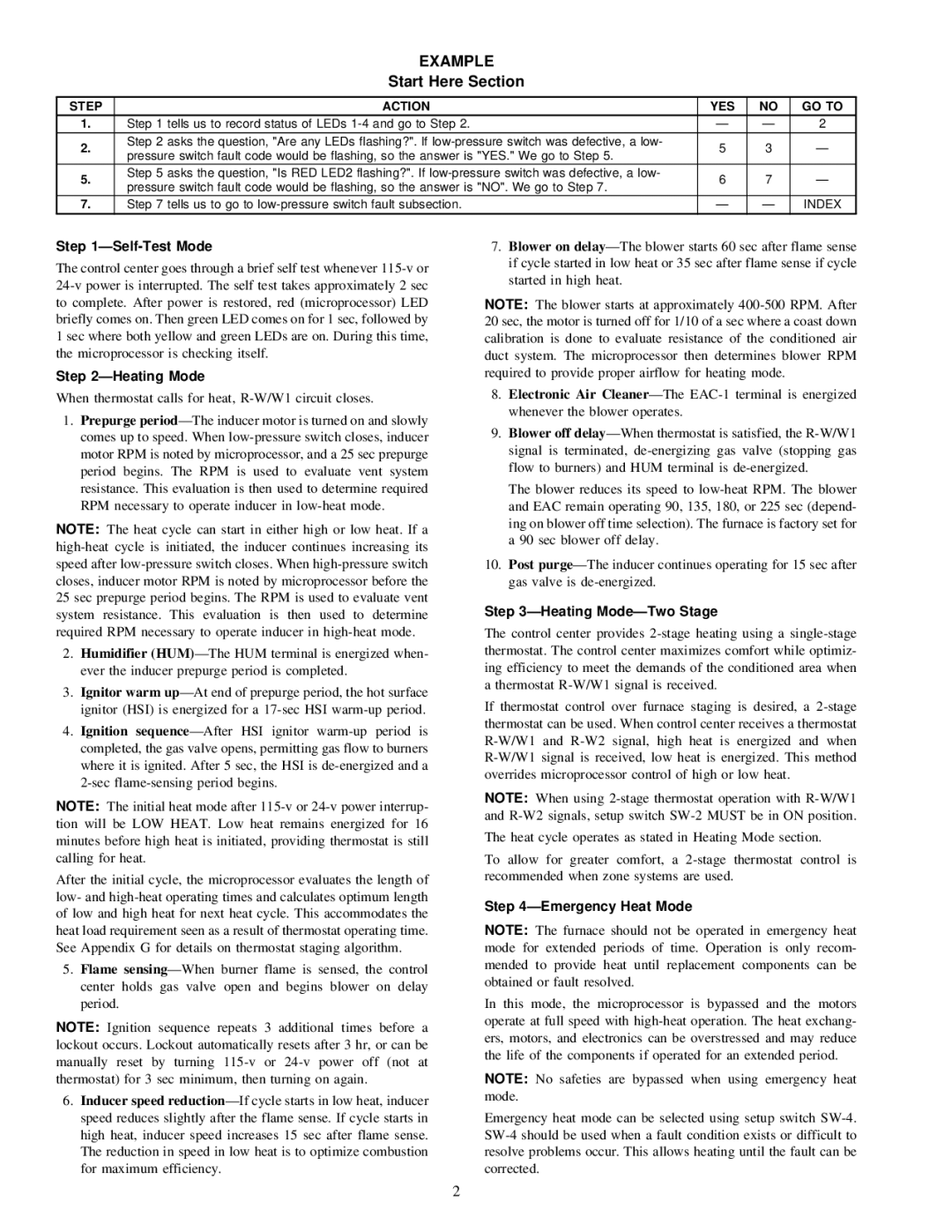Step 1ÐSelf-Test Mode
The control center goes through a brief self test whenever 115-v or 24-v power is interrupted. The self test takes approximately 2 sec to complete. After power is restored, red (microprocessor) LED briefly comes on. Then green LED comes on for 1 sec, followed by 1 sec where both yellow and green LEDs are on. During this time, the microprocessor is checking itself.
Step 2ÐHeating Mode
When thermostat calls for heat, R-W/W1 circuit closes.
1.Prepurge periodÐThe inducer motor is turned on and slowly comes up to speed. When low-pressure switch closes, inducer motor RPM is noted by microprocessor, and a 25 sec prepurge period begins. The RPM is used to evaluate vent system resistance. This evaluation is then used to determine required RPM necessary to operate inducer in low-heat mode.
NOTE: The heat cycle can start in either high or low heat. If a high-heat cycle is initiated, the inducer continues increasing its speed after low-pressure switch closes. When high-pressure switch closes, inducer motor RPM is noted by microprocessor before the 25 sec prepurge period begins. The RPM is used to evaluate vent system resistance. This evaluation is then used to determine required RPM necessary to operate inducer in high-heat mode.
2.Humidifier (HUM)ÐThe HUM terminal is energized when- ever the inducer prepurge period is completed.
3.Ignitor warm upÐAt end of prepurge period, the hot surface ignitor (HSI) is energized for a 17-sec HSI warm-up period.
4.Ignition sequenceÐAfter HSI ignitor warm-up period is completed, the gas valve opens, permitting gas flow to burners where it is ignited. After 5 sec, the HSI is de-energized and a 2-sec flame-sensing period begins.
NOTE: The initial heat mode after 115-v or 24-v power interrup- tion will be LOW HEAT. Low heat remains energized for 16 minutes before high heat is initiated, providing thermostat is still calling for heat.
After the initial cycle, the microprocessor evaluates the length of low- and high-heat operating times and calculates optimum length of low and high heat for next heat cycle. This accommodates the heat load requirement seen as a result of thermostat operating time. See Appendix G for details on thermostat staging algorithm.
5.Flame sensingÐWhen burner flame is sensed, the control center holds gas valve open and begins blower on delay period.
NOTE: Ignition sequence repeats 3 additional times before a lockout occurs. Lockout automatically resets after 3 hr, or can be manually reset by turning 115-v or 24-v power off (not at thermostat) for 3 sec minimum, then turning on again.
6.Inducer speed reductionÐIf cycle starts in low heat, inducer speed reduces slightly after the flame sense. If cycle starts in high heat, inducer speed increases 15 sec after flame sense. The reduction in speed in low heat is to optimize combustion for maximum efficiency.
7.Blower on delayÐThe blower starts 60 sec after flame sense if cycle started in low heat or 35 sec after flame sense if cycle started in high heat.
NOTE: The blower starts at approximately 400-500 RPM. After 20 sec, the motor is turned off for 1/10 of a sec where a coast down calibration is done to evaluate resistance of the conditioned air duct system. The microprocessor then determines blower RPM required to provide proper airflow for heating mode.
8.Electronic Air CleanerÐThe EAC-1 terminal is energized whenever the blower operates.
9.Blower off delayÐWhen thermostat is satisfied, the R-W/W1 signal is terminated, de-energizing gas valve (stopping gas flow to burners) and HUM terminal is de-energized.
The blower reduces its speed to low-heat RPM. The blower and EAC remain operating 90, 135, 180, or 225 sec (depend- ing on blower off time selection). The furnace is factory set for a 90 sec blower off delay.
10.Post purgeÐThe inducer continues operating for 15 sec after gas valve is de-energized.
Step 3ÐHeating ModeÐTwo Stage
The control center provides 2-stage heating using a single-stage thermostat. The control center maximizes comfort while optimiz- ing efficiency to meet the demands of the conditioned area when a thermostat R-W/W1 signal is received.
If thermostat control over furnace staging is desired, a 2-stage thermostat can be used. When control center receives a thermostat R-W/W1 and R-W2 signal, high heat is energized and when R-W/W1 signal is received, low heat is energized. This method overrides microprocessor control of high or low heat.
NOTE: When using 2-stage thermostat operation with R-W/W1 and R-W2 signals, setup switch SW-2 MUST be in ON position.
The heat cycle operates as stated in Heating Mode section.
To allow for greater comfort, a 2-stage thermostat control is recommended when zone systems are used.
Step 4ÐEmergency Heat Mode
NOTE: The furnace should not be operated in emergency heat mode for extended periods of time. Operation is only recom- mended to provide heat until replacement components can be obtained or fault resolved.
In this mode, the microprocessor is bypassed and the motors operate at full speed with high-heat operation. The heat exchang- ers, motors, and electronics can be overstressed and may reduce the life of the components if operated for an extended period.
NOTE: No safeties are bypassed when using emergency heat mode.
Emergency heat mode can be selected using setup switch SW-4. SW-4 should be used when a fault condition exists or difficult to resolve problems occur. This allows heating until the fault can be corrected.
